Norwich Terrier History
The origin of the Norwich Terrier is a tale woven deep within the tapestry of British dog breeding. The breed traces its lineage back to the late 19th century in East Anglia, England. Originally bred to hunt small vermin, particularly rats, this small but tenacious dog quickly became a favorite among university students in Cambridge. They were known to keep Norwich Terriers as pets, and these little dogs often accompanied them on fox hunts.
What’s intriguing is how the Norwich Terrier distinguished itself from its close relative, the Norfolk Terrier. While both breeds initially shared a name and origin, they were eventually determined by ear type. The Norwich boasts prick ears, standing upright with confidence and curiosity. Over time, breeding efforts and recognition by kennel clubs further solidified their status as separate breeds. But throughout history, the Norwich Terrier symbolized British countryside charm and resilience.
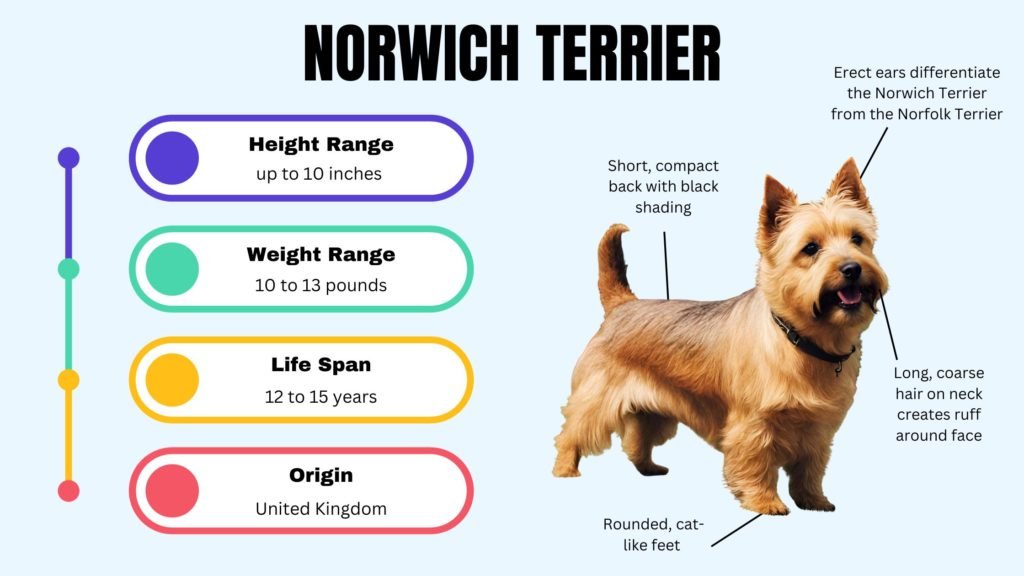
Norwich Terrier Characteristics
The Norwich Terrier might be small in stature but has a powerful presence. One of the most miniature terriers, this breed typically weighs 10 to 12 pounds and stands about 10 inches tall at the shoulder. But don’t let its size fool you. That is a dog of tenacity, spirit, and immense character.
Its dense, wiry coat, which can come in shades of red, wheaten, black and tan, or grizzle, adds to its aesthetic appeal and offers protection against harsh weather conditions. Those familiar with the breed would attest to the Norwich Terrier’s hallmark trait – its expressive, keen eyes, which seem to convey emotions. They are, in essence, the windows to the breed’s inquisitive and spirited soul.
But what truly sets the Norwich Terrier apart is its adaptability. Whether thriving in a city apartment or sprawling countryside, this breed is versatile, making it a suitable companion for many. Yet, it retains its instinct to chase and hunt, so a secure yard or leash during walks is essential.
Norwich Terrier Personality
Ah, the magnetic personality of the Norwich Terrier. That is where the breed truly shines. With an infectious enthusiasm for life, the Norwich Terrier is friendly, affectionate, and loyal to its family. They are known for being eager to please, often going to great lengths to make their human counterparts happy.
However, it’s essential to remember that the Norwich Terrier’s spirited nature requires consistent guidance. As a dog behaviorist, I can’t emphasize setting boundaries and being the ‘pack leader.’ A well-trained Norwich Terrier is a pleasure to be around, but one allowed to rule the roost can develop undesirable behaviors.
Being a terrier, the Norwich has an inherent streak of independence. They’re intelligent and often like to think for themselves, which can sometimes translate to stubbornness. However, this breed can be trained effectively with positive reinforcement and patience.
Socialization is another crucial aspect of the Norwich Terrier’s personality development. Due to their hunting history, they might have a predisposition to chase smaller animals. Hence, early socialization with other pets is crucial.
Norwich Terrier Life Span
When provided with proper care, a balanced diet, and regular veterinary check-ups, the Norwich Terrier often enjoys a long and healthy life span, typically between 12 to 15 years. Like all breeds, they are prone to specific health issues, but many of these can be managed with preventive measures and early detection. Regular exercise, mental stimulation, and a loving environment further ensure that the Norwich Terrier not only lives a long life but a fulfilling one at that.
Norwich Terrier Family Life
In family life, the Norwich Terrier is an exemplary companion. They bond deeply with their human families and are especially good with children, showcasing a gentle and playful demeanor. Their size makes them ideal for both cuddles and playtime, and they are often protective of the little ones in their pack. However, as with all breeds, it’s crucial to supervise interactions between young children and dogs to ensure safety for both.
The Norwich Terrier also thrives on human interaction and companionship. They dislike being left alone for extended periods, so families that can provide regular interaction or even consider the company of another pet might find a more content Norwich Terrier at home.
Norwich Terrier Habitat and Diet
Originating from the English countryside, the Norwich Terrier is adaptable to various living conditions. They can comfortably reside in an apartment with regular exercise and mental stimulation. A small yard or garden is a bonus, but remember, their hunting instincts mean they might dig or chase, so secure fencing is essential.
Diet plays a pivotal role in the Norwich Terrier’s health and well-being. High-quality dog food, whether commercially manufactured or home-prepared (with veterinary supervision), is essential. Fresh water should always be available. Monitoring their weight is crucial, as this small breed can quickly become overweight, leading to various health issues.
Norwich Terrier Temperament
The Norwich Terrier is a dog breed with a temperament that can be described as a blend of spirited zest and lovable affection. They are highly alert and curious and always seem eager to explore their surroundings and engage in new activities. They possess a high level of intelligence, which allows them to pick up on training quickly, but their independent streak can sometimes pose a challenge regarding obedience. As a result, consistent training methods and a firm hand are necessary to help the Norwich Terrier become a well-trained and obedient pet.
These dogs are integral to family activities, outings, and training sessions. They thrive in environments where they can showcase their intelligence and energy. Keeping their minds sharp and spirits high is crucial to their overall well-being. Owners willing to spend quality time with their Norwich Terrier and provide ample opportunities to exercise and engage in mental stimulation will find these dogs excellent companions.
Norwich Terrier Behavior with Other Animals
Given their history as hunters of small vermin, Norwich Terriers possess a high prey drive. This instinct can sometimes make them chase smaller animals, like squirrels or birds. However, with proper socialization from a young age, they can coexist harmoniously with other pets, including cats. Their friendly nature means they often enjoy the company of other dogs, but introductions should be done carefully and gradually to ensure compatibility.
It’s essential to remember that every Norwich Terrier, like all dogs, is an individual. While breed traits provide a guideline, each dog has unique behaviors, preferences, and quirks. As someone who believes in the profound connection between humans and dogs, understanding and respecting these individualities is the key to a harmonious relationship.
Norwich Terrier Coat Color and Grooming
The Norwich Terrier is a breed known for its distinct wiry coat, which serves the dual purpose of giving them their signature look and protecting them from the elements. These terriers typically come in red, black, tan, wheaten, or grizzle colors. Proper grooming is crucial to maintain their coat quality and appearance. Brushing them a few times weekly is recommended to remove dead hair and prevent matting. While they are a low-shedding breed, occasional trimming can be beneficial, especially around the eyes, ears, and paws. In addition to brushing and trimming, it is vital to regularly check their ears, trim their nails, and take care of their dental health to ensure their overall well-being.
Norwich Terrier Health
The Norwich Terrier is generally a healthy breed, but like all dogs, they can be susceptible to specific health issues. Regular veterinary check-ups are crucial to early detection and prevention. Some concerns to be aware of include hip dysplasia, patellar luxation, and certain eye disorders. Always ensure that you acquire a Norwich Terrier from a reputable breeder who conducts necessary health screenings on their breeding dogs.
Norwich Terrier Price
Owning a Norwich Terrier is a rewarding experience, but potential owners should know the initial costs. Depending on the breeder’s reputation, lineage, and location, the price of a Norwich Terrier puppy can range considerably, often from $1,500 to over $3,000. Aside from the initial purchase, owners should budget for regular veterinary care, grooming, training, and high-quality dog food.
Norwich Terrier Trainability
Norwich Terriers are intelligent and quick learners, but their independent nature can sometimes pose challenges in training. Consistency is key. You can shape a well-behaved and obedient companion with a firm yet gentle approach and positive reinforcement techniques. Early socialization is equally vital to ensure they’re well-adjusted adults.
Norwich Terrier Care
Understanding and meeting their basic needs is at the heart of caring for a Norwich Terrier. Regular exercise – playtime in the yard or daily walks – keeps them mentally and physically stimulated. A balanced diet ensures they remain healthy and active. Beyond these basics, they need love, companionship, and engagement. When treated as valued family members, they thrive on human interaction and will reciprocate with unwavering loyalty and affection.
Related Articles
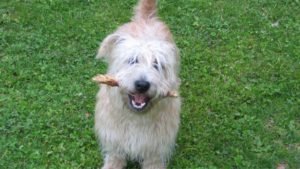
Glen of Imaal Terrier: A Tail of Tenacity and Love

Jack Russell Terrier: Pure Heart, Spirited Soul

Australian Silky Terrier: Thrive in their World

Biewer Terrier: Heartfelt and Genuine

Yorkshire Terrier: A Breed Apart

Norfolk Terrier: The Canine Icon
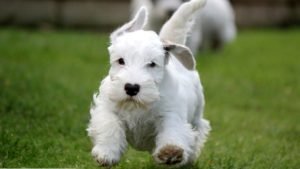
Sealyham Terrier: Boundless Affection
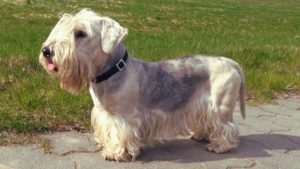
Cesky Terrier: The Canine Dynamo

Scottish Terrier: Small in Size, Grand in Presence
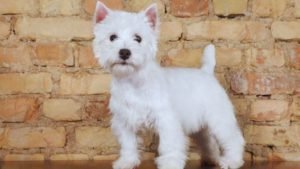
West Highland Terrier: A Bundle of Vigor and Joy

